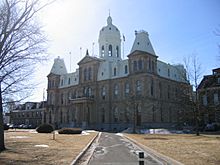Heritage Conservation Act (New Brunswick) facts for kids
Quick facts for kids Heritage Conservation Act |
|
|---|---|

The New Brunswick Legislative Building, part of a complex designated as the "Legislative Assembly Block" Provincial Heritage Place under the Act
|
|
| Citation | SNB 2009, c H-4.05 |
| Territorial extent | New Brunswick |
| Enacted by | Legislative Assembly of New Brunswick |
| Date enacted | February 26, 2010 |
The Heritage Conservation Act (which in French is called Loi sur la conservation du patrimoine) is a law in the Canadian province of New Brunswick. This law helps protect important historical places and areas. It makes sure that buildings, sites, and even old objects that show New Brunswick's history are kept safe for everyone to learn from and enjoy.
Protecting New Brunswick's History
The Heritage Conservation Act helps identify and protect special places in New Brunswick. These places are important because they tell us about the past. Depending on how important they are, they can get different types of protection:
- Provincial Heritage Place: These are places that are very important to the whole province of New Brunswick. The government of New Brunswick, through its Minister of Tourism, Heritage and Culture, officially names these places.
- Municipal Heritage Conservation Area: These are special areas or neighborhoods within a town or city. They have a unique historical look or feel. The local city council decides to protect these areas.
- Local Historic Place: These are places that are important to a specific local community. The city council can name these places, but only if the owner of the property agrees.
Once a place is named a Provincial Heritage Place, you can't change its important features without a special permit from the province. If a place is in a Municipal Heritage Conservation Area, you need a permit from the local heritage board before doing any building or changes. However, if a place is just a Local Historic Place, the owner doesn't have any special rules or restrictions.
The Heritage Conservation Act became law on February 26, 2010. It replaced two older laws: the Historic Sites Protection Act from 1973 and the Municipal Heritage Preservation Act from 1978. Any sites that were protected under the old laws are now protected under this new Act.
Protecting Old Objects and Sites
Section 5 of the Heritage Conservation Act says that the government of New Brunswick owns all very old objects found in the province. This includes objects from archaeological digs (things from ancient human life), paleontological finds (things like fossils from ancient plants and animals), and objects from old burial sites. If an object is from Aboriginal communities, the government holds it "in trust" for those communities. This means they look after it for them.
The Act also gives rules for how experts should do their research and how they should take care of these old objects. It even has rules for people who are not experts but want to explore heritage sites. They can get approval for certain types of exploration. A very important rule in the Act is that if anyone finds a possible heritage object, they must report it to the provincial government. The law also says that you cannot change any heritage place in New Brunswick without getting special government approval first.
Protecting Burial Grounds
Most rules about burial grounds in New Brunswick are in a different law called the Cemetery Companies Act. However, the Heritage Conservation Act also helps protect places where human remains or related objects were placed in the past. This includes old family graves, very ancient burial sites, and cemeteries that are no longer used.
A "burial ground" in this law means any place that has human remains or objects connected to them. If you discover such a site, you must tell the Heritage Branch of the Department of Tourism, Heritage and Culture as soon as you can. You need to tell them where and when you found it. After you report it, the Minister will decide if special steps are needed to protect the site. It is against the law for anyone to change or disturb a burial ground or any objects found there.

